Bodegón II | El arte como reflejo de la esencia humana | / Still Life II | Art as a reflection of human essence |
Bodegón II | El arte como reflejo de la esencia humana |
Still Life II | Art as a reflection of human essence |

El arte como reflejo de la esencia humana
El arte tiene una definición subjetiva y debatible, a lo largo del tiempo los filósofos, historiadores y artistas le han dado diversas definiciones y conceptos tan variados que resulta imposible acordar un concepto en común, "el arte es el recto ordenamiento de la razón" decía Tomás de Aquino, mientras que John Rusk definía al Arte como "La libertad del genio", Y schiller expresaba "El arte es aquello que establece su propia regla". El arte puede tener diversos fines, desde su expresión religiosa hasta su finalidad netamente estética.
El arte desde sus orígenes ha sido una forma de expresión pura del sentimiento humano, desde las pinturas rupestres, encontradas en cavernas, las cuales marcaron los primeros pasos del Homo Sapiens como ser pensante y social, pues estas pinturas estaban directamente relacionadas con sonidos e ideas, básicamente con estas representaciones los primeros humanos se expresaban, una forma de relacionarse con el entorno, este fue uno de los factores que contribuyeron a desarrollar la capacidad cognitiva actual del ser humano.
En el antiguo Egipto el arte tenía una visión casi completamente religiosa, como en el caso de la arquitectura en la cual destacan Templos, Hipogeos y Pirámides. En cuanto a la pintura, en la civilización egipcia se representaba al ser humano de una forma realista, aunque muy arraigadas a los cánones básicos con simbolismo religioso.
En la cuna de la Civilización Occidental, la Antigüedad Clásica Grecorromana, se consideraba al arte como la capacidad de crear, el arte era un sinónimo de destreza en cualquier área productiva que conllevara una seria de reglas ya establecidas, cualquier habilidad en Combate, Pintura, Escultura, Agronomía, etc. era considerado Arte. Aristóteles definió el arte como una "permanente disposición a producir cosas de un modo racional", y Casidoro señaló tres objetivos fundamentales en el arte: Enseñar (Doceat), Conmover (Moveat) y Complacer(Delectet).
Con la expansión del Cristianismo por Europa, apareció el arte Paleocristiano, promovido tras la conversión al cristianismo del emperador Constantino, una corriente artística con connotaciones netamente ligadas a la religión oficial, en la arquitectura se destacó la construcción de Basílicas, y en la pintura, la escenografía religiosa.
El arte Gótico fue desarrollado entre los siglos XII y XVI, caracterizandose por una profunda transformación en la arquitectura, siendo esta evolucionada a formas mas dinámicas y ligeras, estilizando y dando un aspecto mas estético a las construcciones, con espacios mas abiertos, mas entradas y aberturas y por consiguiente, una mayor iluminación, dejando cabida así a la decoración con vitrales y rosetones. La escultura comenzó a desligarse un poco de la arquitectura adoptando una vertiente mas naturalista. La Pintura sobre lienzos de tela comenzó a popularizarse en esta época siendo trabajada con óleos o tempera, desarrollándose cuatro estilos pictóricos diferentes: el gótico lineal o franco-gótico, el gótico flamenco, el gótico itálico o trecentista, y el gótico internacional.
El renacimiento fue una época de gran desarrollo cultural en Europa, la religión permitió cabida al desarrollo tecnológico dando pie a una concepción mas científica de nuestro entorno, el descubrimiento de nuevos continentes le dio la posibilidad a la cultura europea de expandirse por el mundo, universalizándose tras la invención de la imprenta. Se le conoce como Renacimiento ya que el arte de esta época se inspira fuertemente en el Arte clásico Grecorromano, recuperado tras la época del oscurantismo medieval. Se comienza a aplicar el uso de la perspectiva, en la pintura se comienzan a usar formas mas naturalistas y de temáticas paganas o mitológicas, siendo los artistas mas destacados de esta época Leonardo Da Vinci, Alberto Durero, Piero Della Francesca, Botticelli, Rafael, entre otros.
En la edad contemporánea, a partir del año 1800 se sentaron las bases de la sociedad moderna, marcando el fin del absolutismo monárquico e instaurándose los gobiernos democráticos impulsados desde la Revolución Francesa. En cuanto al Arte, comienza una turbulenta transformación la cual culminó en el siglo XX cuando se diversificaron los estilos pictóricos los cuales conviven hasta nuestros días. El Romanticismo fue un movimiento que marcó una gran transformación en todos los géneros artísticos, los artistas destacados dedicaron especial atención a la espiritualidad, la belleza, la fantasía y el sentimiento, de allí proviene el movimiento del Realismo, un género artístico que se enfoca en representar la realidad del entorno fielmente, por lo general, al menos en sus orígenes, se centraba en representar escenas de obreros y campesinos, con un cierto aire de protesta y denuncia social, entre los artistas mas destacados se encuentran Jean-François Millet, Honoré Daumier, Gustave Courbet, entre otros. La primera vertiente artística en romper el canon fue el impresionismo, colocándose al frente de los movimientos modernos vanguardistas, inspirándose en la naturaleza, los artistas pretendían captar una impresión visual de una escena en el lienzo, usando una pincelada suelta, y tonos claros con bajos contrastes, de esta vertiente artística se derivan el Neoimpresionismo y el Postimpresionismo, siendo destacados los artistas Claude Monet, Edgar Degas, Paul Signac, Vinvent Van Gogh, Gauguin, Paul Cézanne, entre otros.
El arte a través de los tiempos ha sufrido grandes transformaciones en conjunto con el desarrollo de la sociedad humana, siempre sujetándose a sus cambios, por consiguiente considero que el arte como tal es un reflejo de la esencia humana tanto en lo individual como en lo colectivo, pues nuestro desarrollo en conjunto depende directamente de nuestra capacidad individual para crear. Se dice que el arte no tiene obligación pues éste es libre, sin embargo, yo considero que el arte tiene la obligación de embellecer el mundo, es por eso que el artista carga con un peso tan grande, pues sobre sus hombros reposa el deber de asegurar un legado, el artista hace honor a la Epopeya de Gilgamesh en su búsqueda incansable por la inmortalidad, aun estando cocientes de que nuestra permanencia en el mundo es temporal, pues la verdadera inmortalidad se encuentra en la huella que dejamos en el mundo, en nuestro legado para con las generaciones futuras, es por eso que los grandes maestros como Leonardo Da Vinci, Miguel Ángel o Van Gogh son considerados inmortales, pues sus obras siguen vigentes en nuestros días y seguirán vigentes en los años venideros, sus nombres seguirán siendo recordados tal vez hasta los últimos días de la propia humanidad. Un artista vive para su arte, se involucra por completo en su obra, y termina convirtiendo su vida misma en una auténtica obra de arte, pues si hay algún rasgo en común que todos los artistas comparten es esa necesidad compulsiva de autodestrucción, como si de esto dependiera para crear las maravillas que aplacan el caos de nuestra humanidad.
Art as a reflection of human essence
Art has a subjective and debatable definition, over time the philosophers, historians and artists have given different definitions and concepts so varied that it is impossible to agree on a common concept, "art is the right order of reason" said Thomas Aquinas, while John Rusk defined Art as "The freedom of genius", and Schiller expressed "Art is that which establishes its own rule." Art can have different purposes, from its religious expression to its purely aesthetic purpose.
Art from its origins has been a form of pure expression of human feeling, from cave paintings, found in caverns, which marked the first steps of Homo Sapiens as a thinking and social being, because these paintings were directly related to sounds and ideas , basically with these representations the first humans expressed themselves, a way of relating to the environment, this was one of the factors that contributed to develop the current cognitive capacity of the human being.
In ancient Egypt, art had an almost completely religious vision, as in the case of architecture in which Temples, Hypogeos and Pyramids stand out. As for the painting, in the Egyptian civilization the human being was represented in a realistic way, although very rooted to the basic canons with religious symbolism.
In the cradle of Western Civilization, Classical Greco-Roman Antiquity, art was considered as the ability to create, art was a synonym of skill in any productive area that entailed a set of established rules, any skill in combat, painting, Sculpture, Agronomy, etc. It was considered Art. Aristotle defined art as a "permanent disposition to produce things in a rational way", and Casidoro pointed out three fundamental objectives in art: Teach (Doceat), Move (Moveat) and Complacer (Delectet).
With the expansion of Christianity in Europe, appeared the Paleo-Christian art, promoted after the conversion to Christianity of the Emperor Constantine, an artistic movement with connotations clearly linked to the official religion, in architecture was highlighted the construction of Basilicas, and in painting, the religious scenery.
Gothic art was developed between the twelfth and sixteenth centuries, characterized by a profound transformation in architecture, being evolved to more dynamic and light, stylizing and giving a more aesthetic to the buildings, with more open spaces, more entries and openings and, consequently, a greater lighting, leaving room for the decoration with stained glass windows and rosettes. The sculpture began to detach a bit from the architecture adopting a more naturalistic slope. Painting on cloth canvases began to become popular at this time being worked with oils or tempera, developing four different pictorial styles: the linear Gothic or Franco-Gothic, the Gothic Flemish, the Italic Gothic or Thirteenth, and the international Gothic.
The Renaissance was a time of great cultural development in Europe, religion allowed room for technological development giving rise to a more scientific conception of our environment, the discovery of new continents gave the possibility to European culture to expand throughout the world, becoming universal after the invention of the printing press. Renaissance is known as the art of this era is strongly inspired by the classic Greco-Roman art, recovered after the era of medieval obscurantism. It begins to apply the use of perspective, in the painting they begin to use more naturalistic forms and pagan or mythological themes, being the most outstanding artists of this era Leonardo Da Vinci, Alberto Durero, Piero Della Francesca, Botticelli, Rafael, among others.
Art through the ages has undergone great transformations in conjunction with the development of human society, always subjecting itself to its changes, therefore I consider that art as such is a reflection of the human essence both individually and collectively , because our development as a whole depends directly on our individual capacity to create. It is said that art has no obligation because it is free, however, I believe that art has the obligation to beautify the world, that is why the artist carries such a large weight, because on his shoulders rests the duty of To ensure a legacy, the artist honors the Epic of Gilgamesh in his tireless search for immortality, even while being aware that our permanence in the world is temporary, because true immortality is found in the footprint we leave in the world, in our legacy to future generations, that is why the great masters such as Leonardo Da Vinci, Michelangelo and Van Gogh are considered immortal, because their works are still valid today and will remain in force in the years to come, their names will continue to be remembered until the last days of the own humanity. An artist lives for his art, is completely involved in his work, and ends up turning his life itself into an authentic work of art, because if there is any feature in common that all artists share is that compulsive need for self-destruction, as if this depended to create the wonders that appease the chaos of our humanity.
El Proceso
The Process
Esta obra esta hecha sobre la mitad cortada de una cartulina tamaño A4, como ya he explicado en post anteriores, me parece bastante cómodo trabajar en este formato, pues ahorro bastante material, ya estoy quedándome sin creyones de nuevo así que debo economizar lo mas que se pueda, además trabajando en este formato pongo un poco mas en práctica la correcta distribución del espacio, ya que como este es mas reducido debo ubicar cuidadosamente los elementos plasmados, como siempre el primer paso fue realizar el boceto, bastante sencillo en este caso debido a la poca cantidad de elementos. El primer elemento que pinté fue la botella del fondo, pues es el elemento mas alejado del primer plano y el que contiene mayor cantidad de detalles.
This work is made on the half cut of a size A4 paper, as I have explained in previous posts, I think it is quite comfortable to work in this format, because I save a lot of material, I am already running out of crayons again so I must save as much as possible. can be, also working on this format put a little more in practice the correct distribution of space, because as this is more reduced I must carefully locate the elements, as always the first step was to make the sketch, quite simple in this case to the small amount of elements. The first element that I painted was the bottom bottle, because it is the element that is farthest from the first plane and the one that contains the most details.
La taza con los pinceles tiene algunos colores que se mezclan sutilmente con el blanco, que dan la impresión de reflejar de forma distorsionada los elementos del entorno, destacándose los brillos amarillos que representan el reflejo del pomo de pintura en la parte inferior y de la botella en la parte de atrás.
The cup with the brushes has some colors that mix subtly with the white, which give the impression of reflecting in a distorted way the elements of the environment, highlighting the yellow shines that represent the reflection of the paint knob on the bottom and the bottle in the back.
Los pomos de pintura de la zona inferior tienen una mezcla entre colores grises, azules, rojos, blancos, verdes y negros, fue todo un desafío darles ese aspecto metálico, fueron los últimos elementos que pinté debido a que estos se encontraban mas cercanos al primer plano, además son los elementos mas pequeños de la obra. Para finalizar rellené el fondo superior de color negro para resaltar el brillo de los elementos frontales, y de color terracota la superficie de la zona inferior que da la impresión de ser una mesa, pintando las respectivas sombras debajo de los objetos para darle mas realismo a la pintura.
The paint knobs of the lower area have a mixture of gray, blue, red, white, green and black, it was a challenge to give them that metallic look, they were the last elements I painted because they were closer to the first flat, in addition they are the smallest elements of the work. Finally, I filled the top black background to highlight the brightness of the front elements, and the terracotta color surface of the lower area that gives the impression of being a table, painting the respective shadows under the objects to give more realism to the painting.
La Obra Finalizada
The Finished Artwork

"La belleza perece en la vida, pero es inmortal en el arte"
"Beauty perishes in life, but is immortal in art"
Leonardo Da Vinci
No olvides dejar un Upvote y seguirme si quieres ver mas trabajos así.
Do not forget to leave an Upvote and follow me if you want to see more works like that.
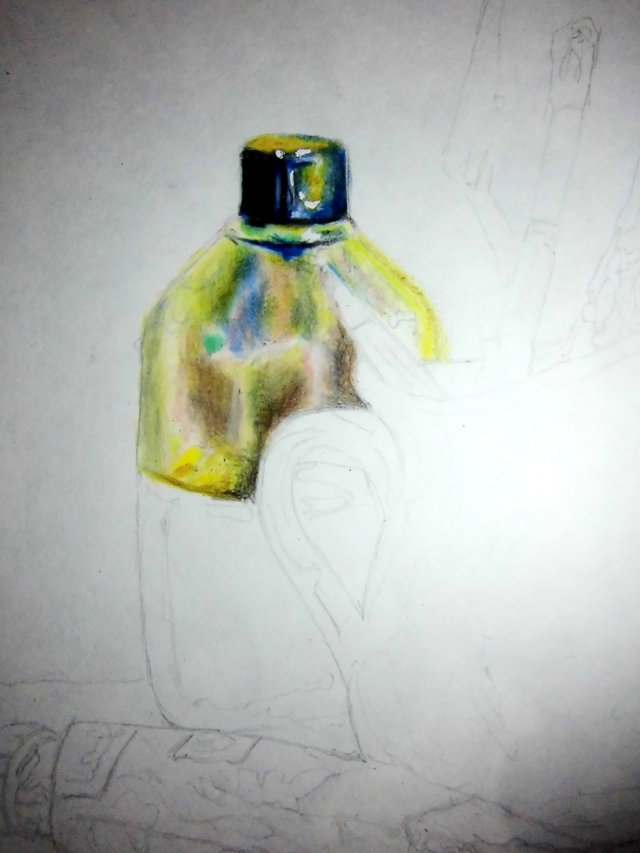
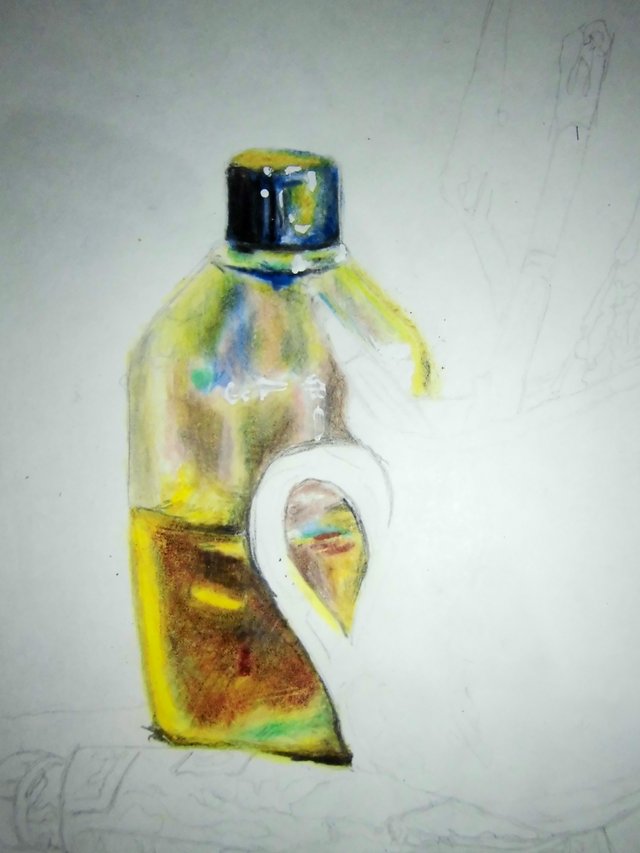
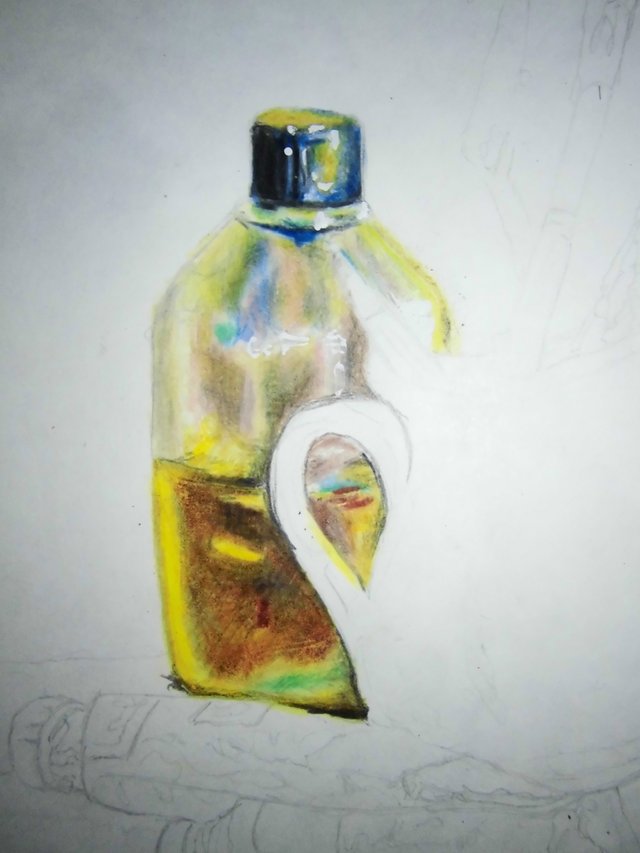
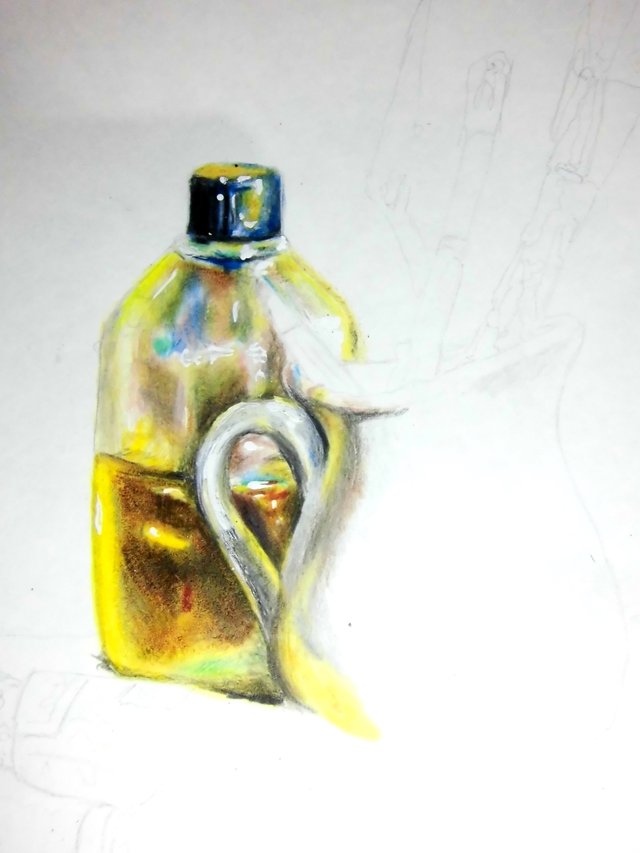
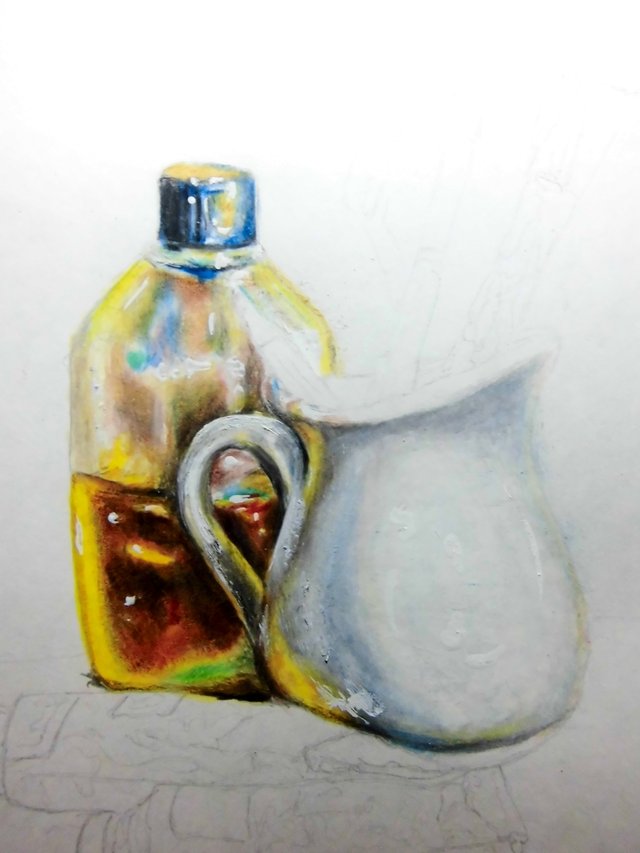
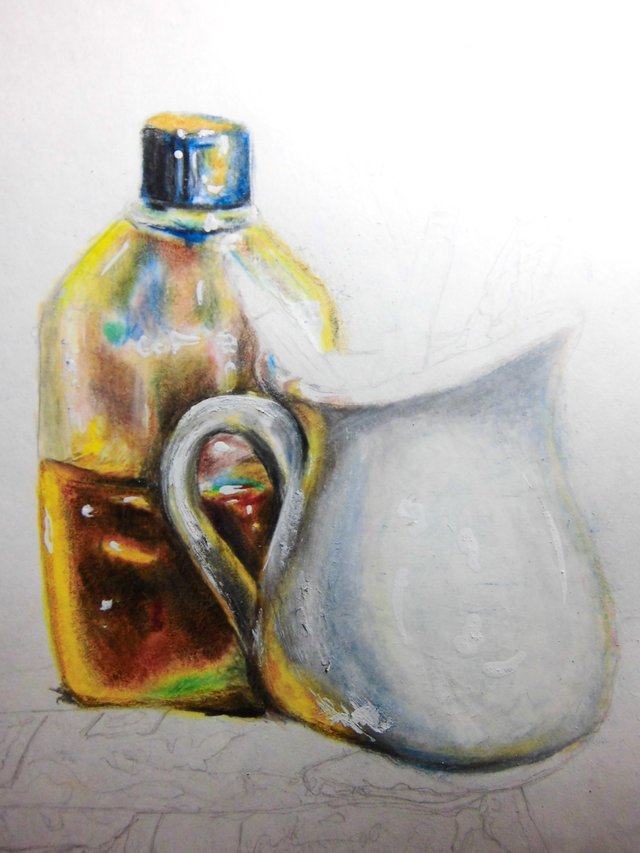
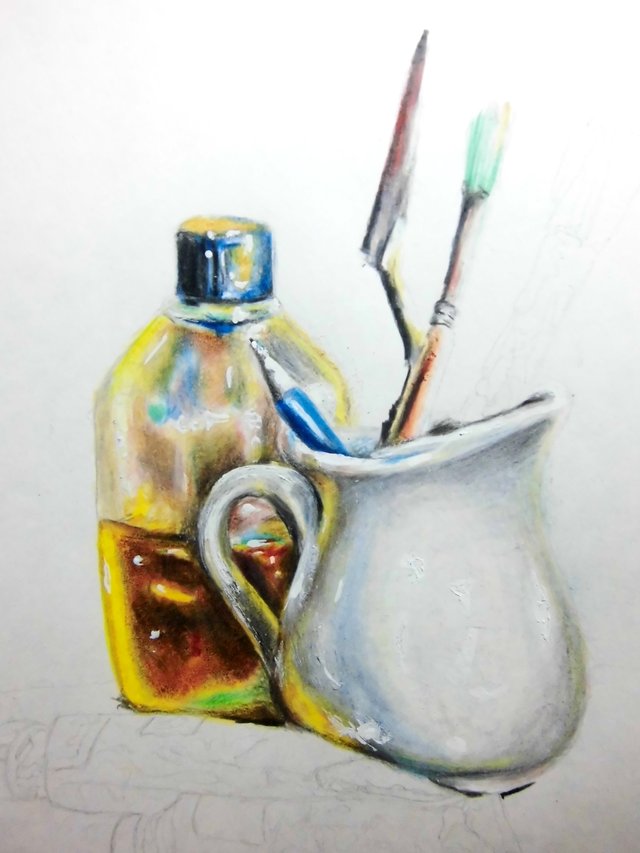
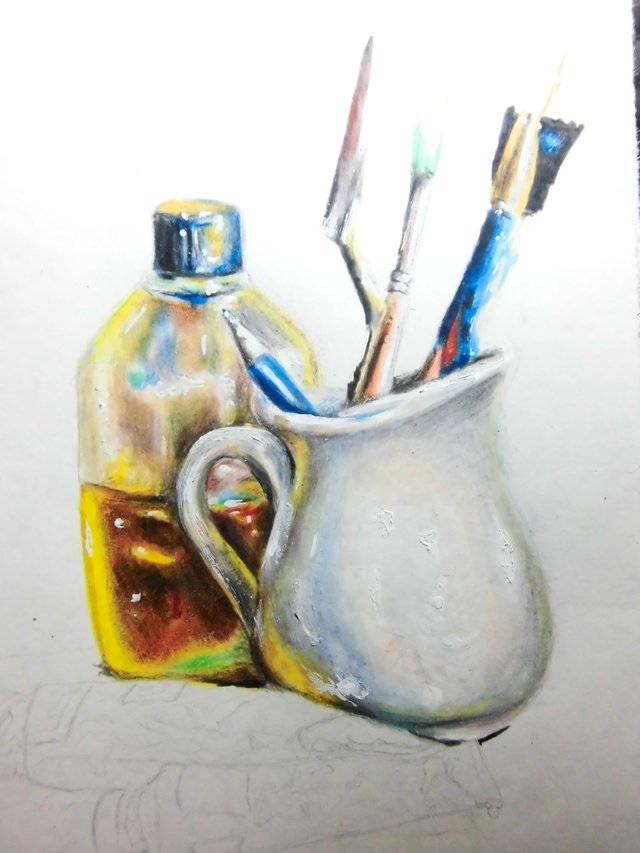
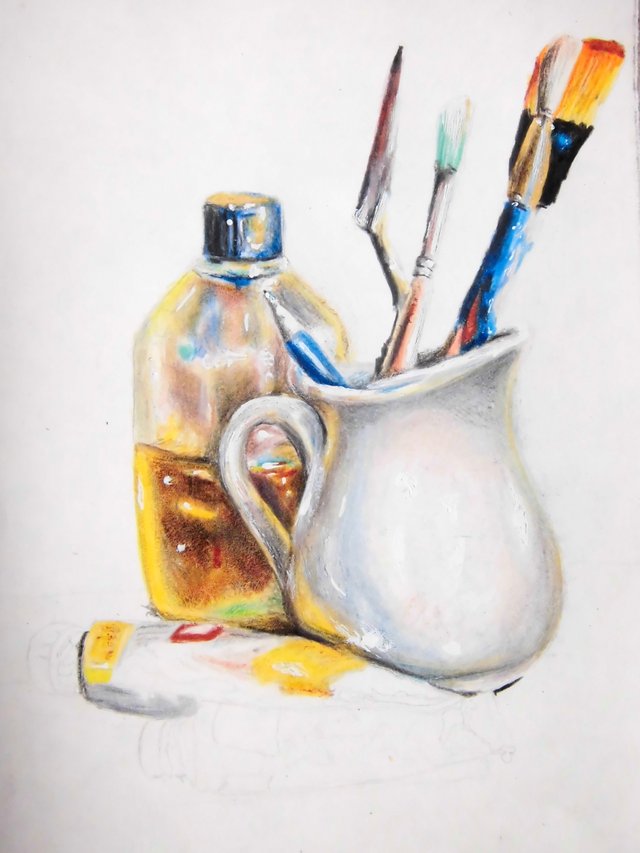
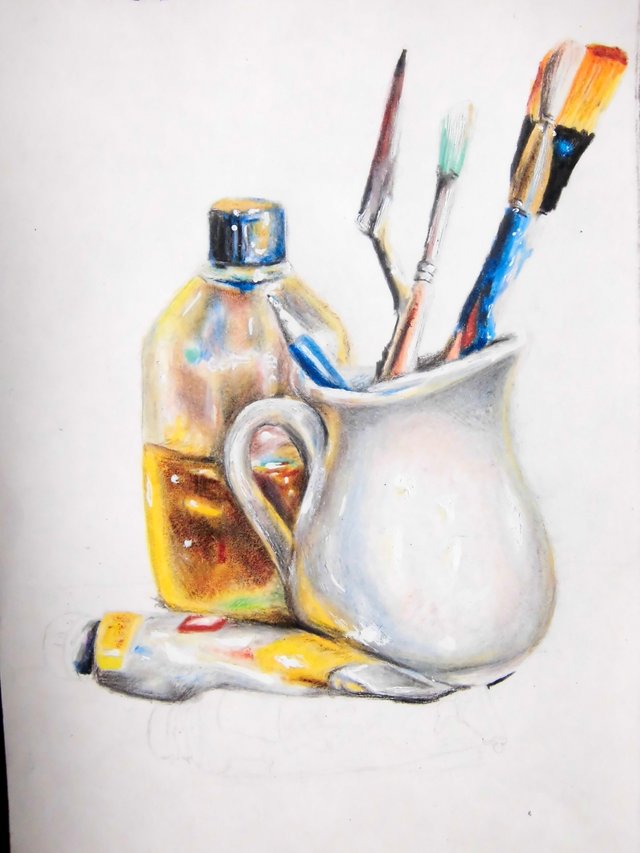
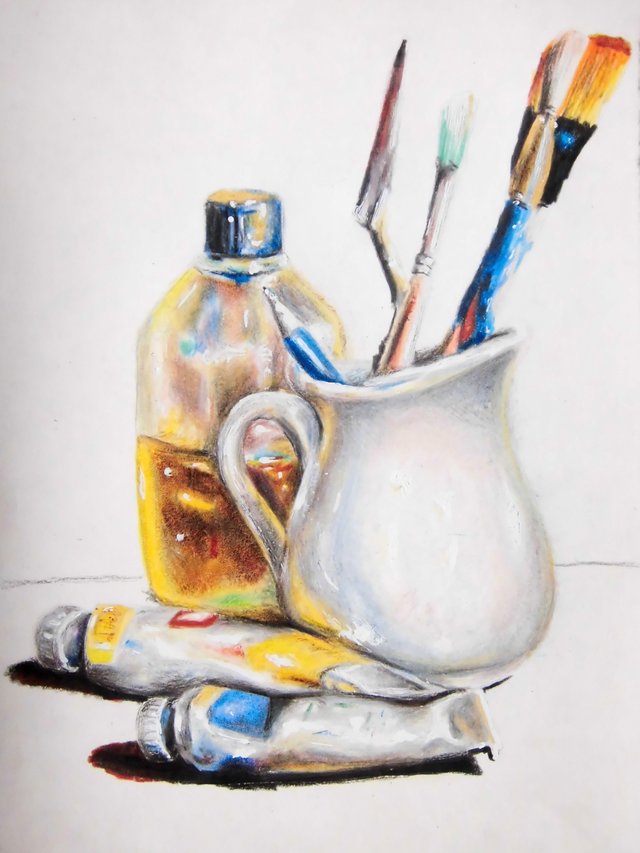
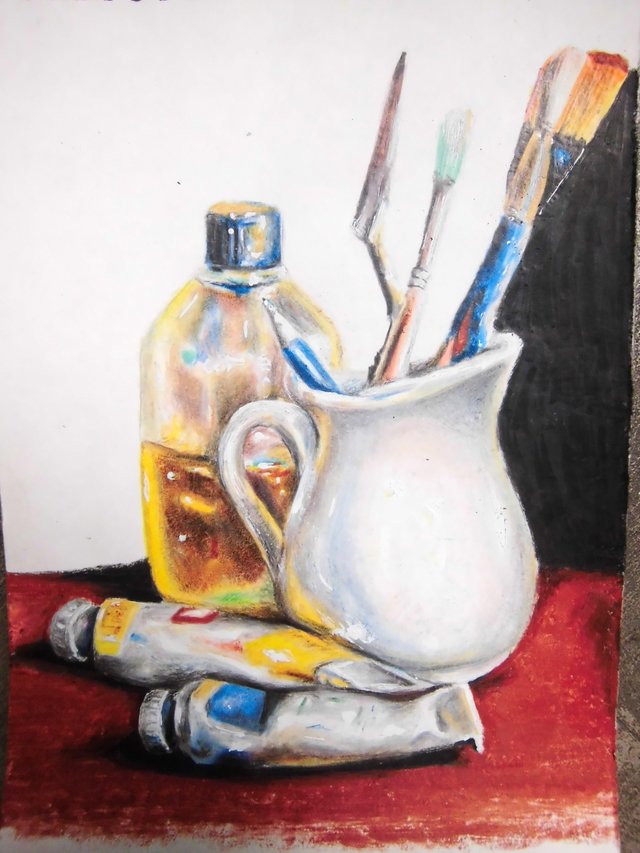
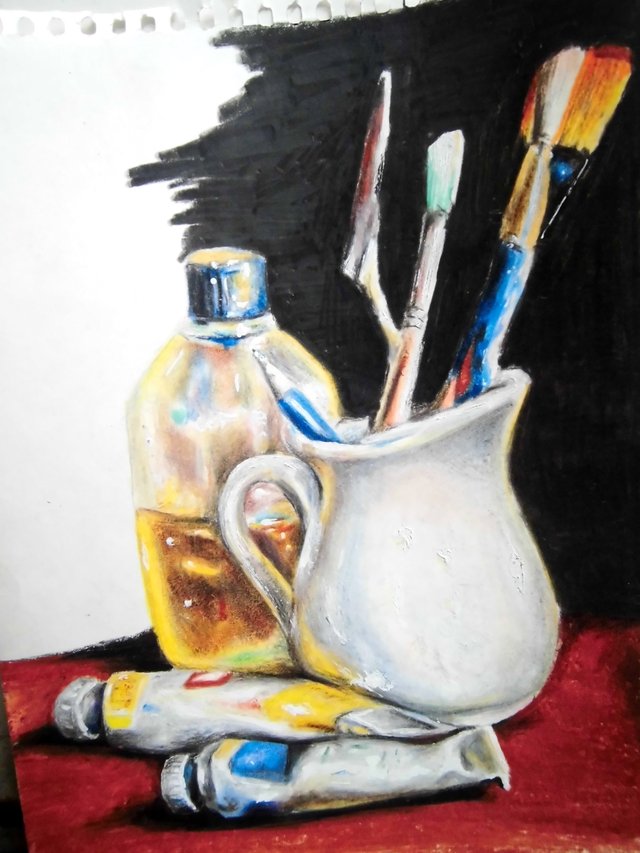
This post was shared in the #spanish-curation channel in the Curation Collective Discord community for curators, and upvoted and resteemed by the @c-squared community account after manual review.
@c-squared runs a community witness. Please consider using one of your witness votes on us here
Gracias!
Hello!
This post has been manually curated, resteemed
and gifted with some virtually delicious cake
from the @helpiecake curation team!
Much love to you from all of us at @helpie!
Keep up the great work!
Defintiivamente tú no bajas el nivel ni por accidente, ¡gran trabajo hermano! Nunca hay suficientes palabras para elogiar este trabajo tan sobresaliente y de calidad tan excepcional, ¡magnífico!
Manually curated by @ilazramusic.
Congratulations @connor-russo! You have completed the following achievement on the Steem blockchain and have been rewarded with new badge(s) :
You can view your badges on your Steem Board and compare to others on the Steem Ranking
If you no longer want to receive notifications, reply to this comment with the word
STOPVote for @Steemitboard as a witness to get one more award and increased upvotes!
Por este gran post te hemos marcado con El Flotador
¡Este post ha sido valorado por @swimproject con un voto de @helpiecake!
Si quieres unirte a nuestra comunidad puedes hacerlo a través del siguiente enlace ---> https://discord.gg/yf6yWau
Gracias!
¡Felicidades! Esta publicación obtuvo upvote y fue compartido por @la-colmena, un proyecto de Curación Manual para la comunidad hispana de Steemit que cuenta con el respaldo de @curie.
Si te gusta el trabajo que hacemos, te invitamos a darle tu voto a este comentario y a votar como testigo por Curie.
Si quieres saber más sobre nuestro proyecto, acompáñanos en Discord: La Colmena.
Gracias!
Muchas gracias!!!
Hola Connor!
Qué dibujo para más increíble el tuyo. En verdad admiro mucho tu arte y la forma tan maravillosa en cómo nos lo muestras. Nos presentas además, una apreciación de la historia del arte muy completa y cómo aporta tanto en la imaginación y transmisión de emociones. Tu paso a paso es excepcional y se puede disfrutar mucho más de tu trabajo. Felicidades.
Has ganado un upvote y una mención especial en nuestro blog. Somos un Proyecto de curación y revista digital de Arte y Cultura. Conoce más de nosotros clickeando en los siguientes iconos:
You have received an upvote and you'll get a special mention on our blog. We are a Curation Project and Art and Culture digital magazine. Learn more about us by clicking on the icons below:
Posted using Partiko Android
Muchas gracias!